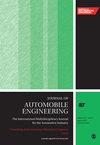Cross-coupling active current balance fast terminal sliding mode control for dual-winding steer-by-wire system
IF 1.5
4区 工程技术
Q3 ENGINEERING, MECHANICAL
Proceedings of the Institution of Mechanical Engineers Part D-Journal of Automobile Engineering
Pub Date : 2024-07-26
DOI:10.1177/09544070241265631
引用次数: 0
Abstract
The dual-winding steer-by-wire (DW-SBW) system is a novel steer-by-wire system with dual-winding permanent magnet synchronous motors, which improves steering capability and safety. However, the current imbalance in two stator windings may lead to increased current harmonic and torque ripple, resulting in steering performance degradation and safety jeopardization. Therefore, in order to improve the current balancing capability of the DW-SBW system, this paper proposes a cross-coupling active current balance control strategy. The dynamic model and the current imbalance model of the DW-SBW system are established. The mathematical relationship between the winding parameters asymmetry and current imbalance is derived, and the impact of current imbalance on current harmonic and steering performance is revealed. A radial basis function (RBF) based active current balance fast terminal sliding mode control (FTSMC) strategy for a DW-SBW system is proposed. The fast terminal sliding mode control is applied to cross-compensate the q-axis current loop control output of the two stator windings, while the RBF neural network is used to estimate the asymmetry of the resistance and inductance parameters of the two windings. The performance of the proposed FTSMC-RBF controller is validated through computer simulations and dual-winding motor experiments. The results demonstrate that the proposed FTSMC-RBF controller is more robust and provides better current balancing performance than the FTSMC in the presence of model parameter uncertainties.用于双绕组转向电线系统的交叉耦合有功电流平衡快速终端滑动模式控制
双绕组线控转向系统(DW-SBW)是一种采用双绕组永磁同步电机的新型线控转向系统,可提高转向能力和安全性。然而,两个定子绕组的电流不平衡可能导致电流谐波和转矩纹波增加,从而导致转向性能下降并危及安全。因此,为了提高 DW-SBW 系统的电流平衡能力,本文提出了一种交叉耦合主动电流平衡控制策略。本文建立了 DW-SBW 系统的动态模型和电流不平衡模型。得出了绕组参数不对称与电流不平衡之间的数学关系,并揭示了电流不平衡对电流谐波和转向性能的影响。针对 DW-SBW 系统提出了基于径向基函数(RBF)的有功电流平衡快速终端滑模控制(FTSMC)策略。快速终端滑模控制用于交叉补偿两个定子绕组的 q 轴电流环控制输出,而 RBF 神经网络则用于估计两个绕组的电阻和电感参数的不对称性。通过计算机仿真和双绕组电机实验,验证了所提出的 FTSMC-RBF 控制器的性能。结果表明,在模型参数不确定的情况下,所提出的 FTSMC-RBF 控制器比 FTSMC 更稳健,并能提供更好的电流平衡性能。
本文章由计算机程序翻译,如有差异,请以英文原文为准。
求助全文
约1分钟内获得全文
求助全文
来源期刊

CiteScore
4.40
自引率
17.60%
发文量
263
审稿时长
3.5 months
期刊介绍:
The Journal of Automobile Engineering is an established, high quality multi-disciplinary journal which publishes the very best peer-reviewed science and engineering in the field.
 求助内容:
求助内容: 应助结果提醒方式:
应助结果提醒方式:


